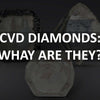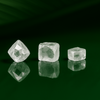
Everything You've Ever Wanted to Know About Lab Grown Loose Diamonds
What is a Lab Grown Diamond?
When a naturally occurring resource fails to meet demands and not pocket and environmental friendly it is only natural for humankind to take things into our hands. Lab grown diamonds are just that.
Understanding Lab Grown Diamonds
Also known as lab created diamonds, manmade diamonds, synthetic diamonds, cultivated diamonds, and cultured diamonds, lab grown diamonds are the gift of scientific advancement to jewelry lovers. Created from scratch in a lab, these diamonds do not leave an impact on the planet as natural diamonds do. When compared to naturally occurring diamonds, lab created diamonds are near impossible to distinguish.

Composed of the same carbon structures as natural diamonds, these diamonds are no different from each other in terms of chemical composition, physical appearance, quality, and color. The only difference is that lab grown diamonds are made by man in lab settings, whereas the other is mined from the Earth. Lab grown diamonds are just like test tube babies they are real just grown in lab.
Processes Behind Lab Created Diamonds
In labs, diamonds are created in settings that mimic the environmental conditions approximately 90 miles below the Earth's surface. Carbon is subjected to extreme temperature and pressure until it turns into a diamond. Two processes are mainly used to produce diamonds efficiently.
High Pressure, High Temperature (HPHT)
The HPHT method starts with a small piece of diamond (called the diamond seed) laced into carbon. The seed is pressurized to approximately 1.5 million pounds per square inch using equipment such as a belt press or cubic press. When this occurs at a temperature over 2,700°F, the carbon starts melting and firms a diamond around the diamond seed. The lab grown loose diamonds are collected when this cools down.
 HPHT Diamond Rough
HPHT Diamond Rough
Chemical Vapor Deposition (CVD)
Compared to HPHT, CVD is a more complicated process. Both HPHT and CVD start the same way, with a diamond seed. In CVD, the seed is placed into a sealed chamber. This chamber is then heated to over 1,400°F and filled with carbon-rich gases. With ionization technology, the gases are ionized into plasma, breaking the gas down. Once this happens, pure carbon sticks to the seed, slowly forming a new diamond. If needed, additional treatments like irradiation are done to add or improve the color of the diamond.

CVD Diamond Rough
The Biggest Trends in Lab Grown Diamonds We've Seen This Year
Recent studies showed millennials and Gen Z are all for man made diamond jewelry. Seeing that natural diamonds are not environment-friendly or ethical, the younger generations have taken to the more sustainable option regarding precious stones. For a group of individuals who have grown up in the cradle of technology, lab grown diamonds do not sound as odd as they did to their predecessors.
The millennials and Gen Z are not only making ethical choices but they are also going for affordable options that make diamonds accessible to a larger portion of people. For instance, lab grown diamonds loose stones such as this 1.70 ct emerald cut beauty are available for a fraction of the price of a conventionally mined diamond. Lab grown loose diamonds are a steal, thanks to the lower prices, brighter fire, and fewer inclusions.
Moreover, colored diamonds are always better when they are created in a lab. This 0.54 CT Princess cut blue lab created diamond is an extremely rare color to find in conventionally mined diamonds. As a lab created diamond, this stone has better clarity and is easily available to those who are tired of regular colorless diamonds. The value of synthetic diamonds is not apparent to the millennials and Gen Z alone. Big names in natural diamonds are slowly taking over the lab created diamond jewelry market.
Millennials and Gen Z are a set of individuals who give more importance to the processes involved and the message conveyed by the products they consume. This is why they opt for cruelty-free, eco-friendly, and affordable lab created diamond that is transparent in their business. Since the younger generations find personalization crucial in everything they do, loose diamonds give them an opportunity to experiment with precious jewelry. The hunt for fashionable bespoke jewelry that does violate principles has led to synthetic diamonds being the biggest trend among the younger generation this year.

Why the Biggest Myths About Lab Grown Loose Diamonds May Actually Be Right
There are many misconceptions surrounding lab created diamond jewelry, and most are baseless. For instance, claiming that lab grown diamonds are fake diamonds could not be further from the truth. However, there are a few myths about lab created diamonds that have a bit of truth to them.
There is an assumption that lab grown loose diamonds are graded differently than the ones mined. This myth is almost a half-truth. The Gemological Institute of America, also known as GIA, is a diamond grading lab that takes a slightly different approach to grading natural and lab grown diamonds.
Since they have broader category classifications for the color and category of lab grown diamonds loose stones, lab grown diamonds receive a 'near colorless' grade instead of an H color grade like a natural diamond. The same applies to grading inclusions as well. A stone would receive a 'very slightly included' instead of VS1 or VS2 for clarity when it is created in a lab.
This method of grading is restricted to the GIA alone. Other labs have not modified the grading method and still follow the standard technique for all the diamonds, regardless of their origin.
Lab Grown Diamonds: Expectations vs. Reality
If you are looking to make custom jewelry for your loved one, finding the best manmade diamond might be in your best interest. Unlike natural diamonds, lab grown diamonds as loose stones give you a more comprehensive range of options to explore. Many people stay back from getting the exquisite jewelry they want just because of unrealistic beliefs about synthetic diamonds.

Lab Created Diamonds are Very Different from the Natural Ones
People expect cultured diamonds to be significantly different from mined ones. Chemically, both diamonds are just the same. Even to a highly professional eye, distinguishing cultured and natural diamonds is difficult. The only significant difference between these stones is the process involved in their formation. One takes place under the Earth's surface for centuries, whereas the other is formed quickly in a controlled setting.
Cultured Diamonds are Poor in Quality
Diamond is said to be the epitome of class and splendor, but what would you do if the diamond is poor in quality? This doubt has kept many interested parties from making synthetic diamonds their choice. Interestingly, lab created diamonds are higher in quality and clarity than naturally occurring diamonds. Since they are not subjected to harsh natural conditions and mining practices, they also tend to suffer from fewer inclusions.
Lab Created Diamond Jewelry is Not That Durable
When it comes to durability, both synthetic and natural diamonds are the same. With identical chemical composition and structure, both score 10 on the Mohs hardness scale. With the indication that these stones are incredibly scratch-resistant, you don't need to worry about wearing them regularly. You don't have to worry about either of the precious stones becoming scratched and cloudy. They are equally prone to cleavage in case of the right kind of impact during accidents.
Synthetic Diamonds Have No Value
Diamonds, in general, do not see much resale value. Compared to natural diamonds, synthetic ones have even lower resale value. This is not to say that lab created diamonds are worthless. Depending on the size or design of the jewelry, you might be able to get a value in return. However, they are not meant to be treated as investment pieces but rather as a beautiful craft.
Lab Grown Diamonds And Moissanite are the Same

Moissanite and cultured diamonds are two completely different gemstones. Though moissanite has numerous similarities to cultured diamonds, the significant difference is that diamonds are made from carbon structures, whereas moissanite is composed of silicon carbide. In addition, moissanite has a rainbow-like sparkle, and diamonds have a subtle white brilliance. In most situations, moissanite is a great alternative to both natural and lab grown diamonds.
Summing It Up
Lab grown loose diamonds are seeing an uptick in demand, and it is all for the best. People are finding more environment-friendly and ethical options to obtain their jewelry from. Even though natural diamond mining conditions are not as despicable as before, earning the moniker 'blood diamond', concerns about sustainability and human rights still exist.
When there is an affordable and unproblematic option of lab created diamond jewelry, look no further. Looking as splendid as natural diamonds, cultured diamonds can be a girl's new best friend. Once you weigh the risks and benefits of natural and synthetic diamonds, the choice is unanimously going to be the latter.
Find the Best Man Made Diamond Jewelry Now
Once you have made up your mind to indulge in some lab created diamonds, Diamondrensu can help you find the right stone for you. From picking the right color and cut to choosing the perfect custom design, get in touch with Diamondrensu now.
Leave a comment
Please note, comments must be approved before they are published.









